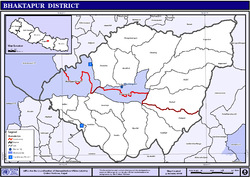 ?
? 
Here is wiki news on Nagarkot massacre...This one seems like a non political event though....Just one Crazy RNA officer going Loco on the locals.
Nagarkot massacre
| Nagarkot massacre | |
|---|---|
 Bhaktapur district |
|
| Location | Chihandanda, Nepal |
| Date | December 14, 2005 11:30 p.m. (UTC+5:45) |
| Weapon(s) | L1A1 SLR |
| Death(s) | 12 (including the perpetrator) |
| Injured | 19 |
| Perpetrator | Basudev Thapa |
The Nagarkot massacre was an act of mass murder that occurred on December 14, 2005 at the Kali Devi temple in Chihandanda near Nagarkot, Nepal. Off-duty RNA sergeant Basudev Thapa (वासुदेव थापा), 26, indiscriminately shot at villagers, celebrating at the temple, with an assault rifle, killing 11 and injuring 19 more, before he himself was shot by his fellow soldiers. The shooting was said to be sparked by an argument between Thapa and some of the villagers.[1][2]
Contents[hide] |
[edit] Shooting
While nearly 250 villagers were celebrating Mangsir Purnima at the Kali Devi temple in Chihandanda an argument broke out between Sergeant Basudev Thapa, stationed at the Nagarkot barrack, and youths from the nearby Pipalbot village with whom he had a long-standing enmity.[3] When the youths began to beat him up, the allegedly drunk soldier attacked one of them with a knife. Yelling "I'll come back and kill you all" Thapa, bruised from the fight, drove off in his motorcycle[4] and returned to the barracks, where he armed himself with an L1A1 SLR. Although he was off-duty at that time, Thapa was allowed to leave the barracks with the gun without fulfilling any formality.[5]
After about half an hour, at 11.30 p.m., Thapa and three of his colleagues[3] returned to the temple grounds. He fired a few shots in the air, before shooting indiscriminately at the people who were trying to seek refuge within the temple from the gunman.
Though many initial news reports named 12 civilians killed, the official report states that only 11 people were shot to death and 19 others wounded by the more than 200 shots fired,[6] before Thapa himself was killed. According to RNA statements, Thapa committed suicide, though many witnesses said that he was killed by one of his colleagues, while he was still firing at the villagers.[3] An investigation of Thapa's body found that he died of a chest wound that could not possibly have been self-inflicted,[5] thus contradicting the official version.[7][8]
[edit] Victims
|
|
|
[edit] Aftermath
The next day the RNA commenced to clean the crime scene, deliberately destroying evidence, presumably in an attempt to cover up the incident.[5] When a second rifle was found in a pool about 60 metres away from Thapa's body, questions arose if there might have been a second gunman.[3][8]
In consequence human rights activists and opposition parties, as well as the people from Nagarkot demonstrated, demanding an impartial investigation and denouncing frequent human rights violations by and severe corruptness and indiscipline within the RNA. As a response the government formed a three-member judicial commission to investigate the incident and proposed to pay compensations of 150,000 Nepalese rupees to each of the victims families and to bear the expenses for treating the injured. Further the RNA also established a probe committee to scrutinise the massacre.[7]
The official report was released on January 3, 2006 and stated, that "Thapa committed suicide by shooting himself and no evidence was found of the involvement of any other person except Thapa in the incident". Further it was noted that Thapa had a history of indiscipline and obstructing work and that the leading officer of the Nagarkot barracks had failed to maintain discipline among his personnel. The report also recommended to compensate the victims and their families and to take care of their education and livelihood.[9]
Victims of the massacre protested several times in Kathmandu, because of the passivity of the government in providing the compensations recommended by the probe committee.[10][11]
